The History of the Use of Postcards
On October 1, 1869, Austria became the first country to formally issue a postal stationary card to which postage was required to be affixed. These cards became the first of what we today know as postcards. While earlier unofficial private postcards and envelopes with printed images had been circulated, this new format quickly spread to other European countries, including the United Kingdom on October 1, 1870. Canada became the first non-European nation to issue such a card on June 1, 1871, at that time, one of the first dozen nations to have such cards. On May 12, 1873, the United States released a similar type of card, as did Japan in December 1873.
The General Postal Union, which later became the Universal Postal Union, was the body to govern international postal rates for postcards sent internationally. In 1874, the General Postal Union set the cost of mailing a card at one half the rate of a first class letter. In 1875, an agreement between Canada and the USA set the international rate for postage for postcards between the two countries at the same rate as domestic postcards. In 1877, Japan joined the General Postal Union. Canada was accepted into the General Postal Union on July 1, 1878. At that time, the rate for mailing an international postcard was one penny in Britain, and two cents in each of Canada and the USA. These rates applied to a list of countries who were signatories to the U.P.U. agreements, however a second group of countries whose rates were higher domestically were subject to higher international postcard rates.
In the USA, on May 19, 1898 the Private Mailing Card Act eliminated the difference in private cards and government issue cards. Though writing was not allowed on the address side or back of these cards. The term "Postcard" was not allowed until December 24, 1901 to private printers in the USA.
In Japan, in 1900, a revision of the postal act allowed private, non-governmental, postcards to be made and used. In January of 1902, divided back postcards were permitted in Great Britain. On December 18, 1903, this same style of card was allowed in Canada. In 1904, France followed suit, with Germany in joining to permit divided back postcards in 1905. On March 1, 1907, divided back postcards were permitted in the USA. On March 28, 1907, divided back postcards were permitted in Japan. This allowed messages to be written on the address side of the card.
Initially, in Japan, the line dividing the card was not at the center of the card, as only one-third of the card was used for message writing; the balance was reserved for the addressee's name and address. From March 1, 1918, the dividing line was moved on Japanese postcards to the center of the card. From July 22, 1905, private Japanese postcards were allowed to have a foreign-language designation such as "Carte Postale" or "Post Card" in addition to the Japanese "Yubin hakaki" (which, of course, appears in Japanese characters).
During the first half dozen years of the twentieth century, the publishing of printed postcards grew rapidly, doubling almost every six months. European publishers imported millions of high quality postcards into Canada and the USA. By 1907, European publishers accounted for over 75% of all postcards sold in the USA.
Stefano Neis reports that, by 1908 "the picture postcard hobby became the greatest collectible hobby that the World has ever known. The official figures from the U.S. Post Office for the fiscal year ending June 30, 1908, cite 677,777,798 postcard mailed. That was at a time when the total population of the U.S. was 88,700,000." The "Golden Age" of postcards is regarded to have lasted until 1915.
Prior to World War I, Germany was the source of many of the best quality postcards, using lithography processes to create images of almost photographic quality. With the advent of hostilities, some countries sought to develop their own postcard printing industries in the face of the loss of Germany as a supplier. The German postcard industry never recovered after the war.
After World War 1 and up until around 1930, the demand for postcards was still great. As countries such as the USA and Canada sought to grow their postcard printing industries, the White Border card appeared as a cost saving measure. The white space on the front of cards saved ink, but the cards were generally of inferior quality to the German cards they replaced.
As inexpensive card printing processes improved in Canada and the USA, a Linen type card was developed allowing cheaper, more vivid inks, and a paper that had a cloth-like finish.
Since the close of World War II, the Chrome process of postcard reproduction has become the most popular form of printing. This process allowed cards to carry the image of real colour photos, and became the mainstay of postcard printing in the second half of the 20th century.in the second half of the 20th century.
On October 1, 1869, Austria became the first country to formally issue a postal stationary card to which postage was required to be affixed. These cards became the first of what we today know as postcards. While earlier unofficial private postcards and envelopes with printed images had been circulated, this new format quickly spread to other European countries, including the United Kingdom on October 1, 1870. Canada became the first non-European nation to issue such a card on June 1, 1871, at that time, one of the first dozen nations to have such cards. On May 12, 1873, the United States released a similar type of card, as did Japan in December 1873.
The General Postal Union, which later became the Universal Postal Union, was the body to govern international postal rates for postcards sent internationally. In 1874, the General Postal Union set the cost of mailing a card at one half the rate of a first class letter. In 1875, an agreement between Canada and the USA set the international rate for postage for postcards between the two countries at the same rate as domestic postcards. In 1877, Japan joined the General Postal Union. Canada was accepted into the General Postal Union on July 1, 1878. At that time, the rate for mailing an international postcard was one penny in Britain, and two cents in each of Canada and the USA. These rates applied to a list of countries who were signatories to the U.P.U. agreements, however a second group of countries whose rates were higher domestically were subject to higher international postcard rates.
In the USA, on May 19, 1898 the Private Mailing Card Act eliminated the difference in private cards and government issue cards. Though writing was not allowed on the address side or back of these cards. The term "Postcard" was not allowed until December 24, 1901 to private printers in the USA.
In Japan, in 1900, a revision of the postal act allowed private, non-governmental, postcards to be made and used. In January of 1902, divided back postcards were permitted in Great Britain. On December 18, 1903, this same style of card was allowed in Canada. In 1904, France followed suit, with Germany in joining to permit divided back postcards in 1905. On March 1, 1907, divided back postcards were permitted in the USA. On March 28, 1907, divided back postcards were permitted in Japan. This allowed messages to be written on the address side of the card.
Initially, in Japan, the line dividing the card was not at the center of the card, as only one-third of the card was used for message writing; the balance was reserved for the addressee's name and address. From March 1, 1918, the dividing line was moved on Japanese postcards to the center of the card. From July 22, 1905, private Japanese postcards were allowed to have a foreign-language designation such as "Carte Postale" or "Post Card" in addition to the Japanese "Yubin hakaki" (which, of course, appears in Japanese characters).
During the first half dozen years of the twentieth century, the publishing of printed postcards grew rapidly, doubling almost every six months. European publishers imported millions of high quality postcards into Canada and the USA. By 1907, European publishers accounted for over 75% of all postcards sold in the USA.
Stefano Neis reports that, by 1908 "the picture postcard hobby became the greatest collectible hobby that the World has ever known. The official figures from the U.S. Post Office for the fiscal year ending June 30, 1908, cite 677,777,798 postcard mailed. That was at a time when the total population of the U.S. was 88,700,000." The "Golden Age" of postcards is regarded to have lasted until 1915.
Prior to World War I, Germany was the source of many of the best quality postcards, using lithography processes to create images of almost photographic quality. With the advent of hostilities, some countries sought to develop their own postcard printing industries in the face of the loss of Germany as a supplier. The German postcard industry never recovered after the war.
After World War 1 and up until around 1930, the demand for postcards was still great. As countries such as the USA and Canada sought to grow their postcard printing industries, the White Border card appeared as a cost saving measure. The white space on the front of cards saved ink, but the cards were generally of inferior quality to the German cards they replaced.
As inexpensive card printing processes improved in Canada and the USA, a Linen type card was developed allowing cheaper, more vivid inks, and a paper that had a cloth-like finish.
Since the close of World War II, the Chrome process of postcard reproduction has become the most popular form of printing. This process allowed cards to carry the image of real colour photos, and became the mainstay of postcard printing in the second half of the 20th century.in the second half of the 20th century.
Early Postcards
- French Carte Postale, 1877
- Newfoundland Post Card, 1873
- Canada Post Card, 1871
- CPR Postcard 1890
- Barrie postcard 1895
- RB Andrews 1895
- Postal Stationery card 1898
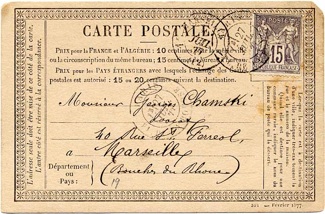
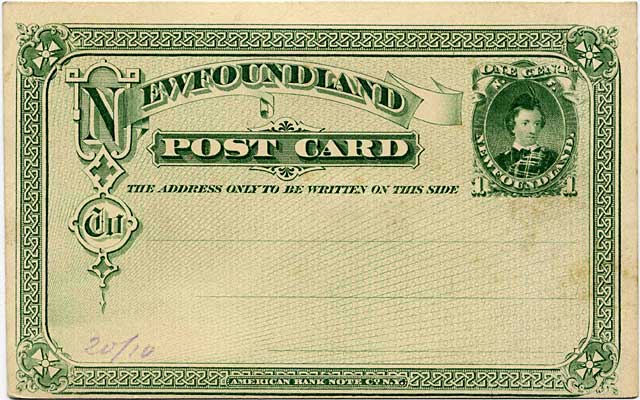
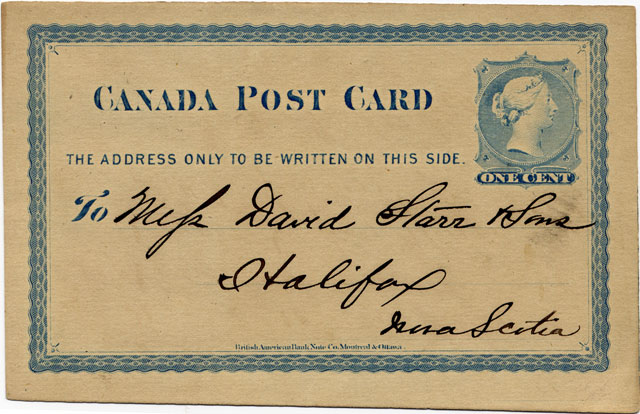
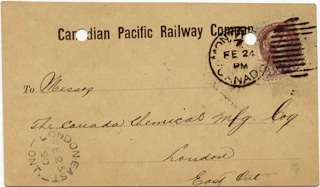
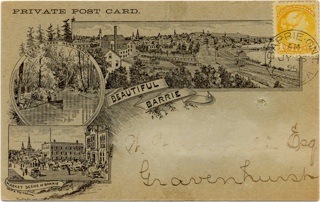
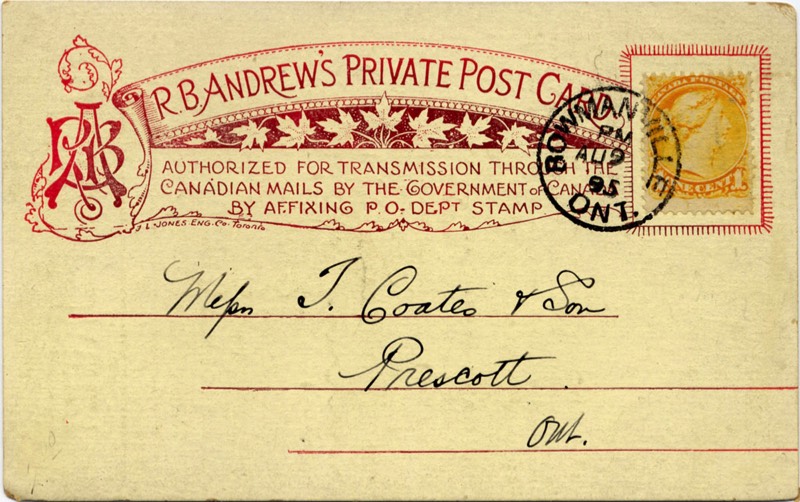
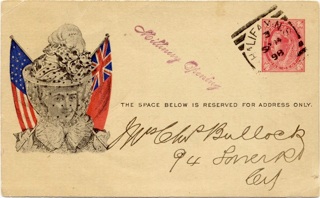
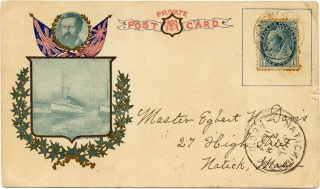
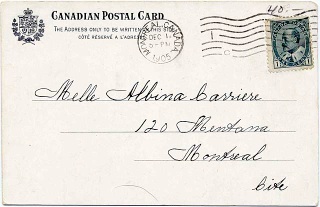
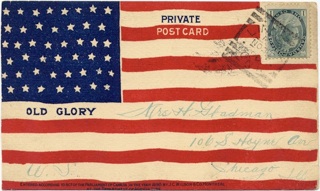
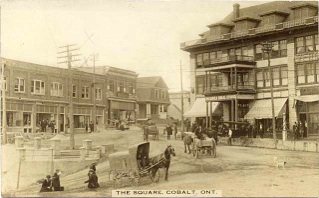
Postcard Eras
The following descriptions can be helpful in identifying the age of postcards (their "eras").
Pioneer Era - 1870 to 1898
Pioneer era postcards are scarce and difficult to locate. Several characteristics of the card will indicate the postcard is from this era. All will have undivided backs, the title on the back of the card most commonly read "Souvenir Card" or "Mail Card", and, in the USA, none will be marked with the "Authorized by Act of Congress". Many also have "souvenir of..." or "greetings from..." on the front.
Private Mailing Card Era - 1898 to 1901
May 19, 1898, in the USA, private printers were granted permission to print and sell postcards. All cards of this era will say "Private Mailing Card" on the back. PMC is commonly used as an abbreviation of Private Mailing Card
Undivided Back Era - 1901 to 1902
(Great Britain) 1903 (Canada) and 1907 (USA & Japan)
These postcards only permitted the sender to use the back of the card to write the address to whom the postcard was being mailed. Therefore, the sender was forced to right their message on the front side of the card. Often, directly over the picture printed on the card. Undivided Back Postcard is also abbreviated UBPC.
Divided Back Era - 1902
(Great Britain) 1903 (Canada) and 1907 (USA & Japan) to 1915
The divided back postcard allowed the front (picture side) of the card to remain free from messages; the sender would write both the message and recipient's address on the back side. The fronts of these cards are typically filled entirely with a scene or image. No white border is present. These cards were permitted in the UK as of January 1902 and in Canada as of Dec. 18, 1903.
White Border Era - 1915 to 1930 (Canada & USA)
White border cards have a white frame surrounding the image or scene on the front of the postcard. Most cards from this era were printed domestically in the USA or Canada permission to print and write both the message and recipient's address on the back side. The fronts of these cards are typically filled entirely with a scene or image. No white border is present.
White Border Era - 1915 to 1930 (Canada & USA)
White border cards have a white frame surrounding the image or scene on the front of the postcard. Most cards from this era were printed domestically in the USA or Canada.
Linen Era - 1930 to 1945
Canadian and American publishers began to produce cards printed on a linen type of paper which contained a high rag content. These cards showed very bright and vivid colors, and held up well under use.
Japan - "Hakaki" changes to "Hagaki" - February 15, 1933
On February 15, 1933 on Japanese postcards, the word "Hakaki" was changed to read "Hagaki" (written in Japanese script).
Japanese Reading Style - 1945 - present
After World War II, the Japanese reading style, until this time from right to left, changed to left to right (for horizontal writing). This also affected captions for pictures.
Chrome Era Chrome (Standard-Size) 1939 - present
Chrome (Continental-Size) 1970s - present Chrome postcards can be distinguished by their glossy surface and their beautiful chrome colours. Standard-size cards are 3.5" x 5.5", while continental-sized cards are 4" x 6". In the USA, chrome cards were first available before WWII, and, following the war, became the dominant type of postcard.
Real Photo Postcards - 1900 to current
Real Photo postcards have been available spanning most of the 20th century. On some cards the process used to print the card is noted on the back. ie... kodak, kruxo, velox, azo, ekc. Around 1906, Eastman-Kodak issued an affordable "Folding Pocket Kodak" camera which allowed the public to take black & white photographs and have them printed directly onto paper with postcard backs, with an identifying caption or comment made on the negative itself with an attached metal scribe. The negatives for these postcards were the full size of the postcard, often resulting in very clear detail on the resulting card.
The following descriptions can be helpful in identifying the age of postcards (their "eras").
Pioneer Era - 1870 to 1898
Pioneer era postcards are scarce and difficult to locate. Several characteristics of the card will indicate the postcard is from this era. All will have undivided backs, the title on the back of the card most commonly read "Souvenir Card" or "Mail Card", and, in the USA, none will be marked with the "Authorized by Act of Congress". Many also have "souvenir of..." or "greetings from..." on the front.
Private Mailing Card Era - 1898 to 1901
May 19, 1898, in the USA, private printers were granted permission to print and sell postcards. All cards of this era will say "Private Mailing Card" on the back. PMC is commonly used as an abbreviation of Private Mailing Card
Undivided Back Era - 1901 to 1902
(Great Britain) 1903 (Canada) and 1907 (USA & Japan)
These postcards only permitted the sender to use the back of the card to write the address to whom the postcard was being mailed. Therefore, the sender was forced to right their message on the front side of the card. Often, directly over the picture printed on the card. Undivided Back Postcard is also abbreviated UBPC.
Divided Back Era - 1902
(Great Britain) 1903 (Canada) and 1907 (USA & Japan) to 1915
The divided back postcard allowed the front (picture side) of the card to remain free from messages; the sender would write both the message and recipient's address on the back side. The fronts of these cards are typically filled entirely with a scene or image. No white border is present. These cards were permitted in the UK as of January 1902 and in Canada as of Dec. 18, 1903.
White Border Era - 1915 to 1930 (Canada & USA)
White border cards have a white frame surrounding the image or scene on the front of the postcard. Most cards from this era were printed domestically in the USA or Canada permission to print and write both the message and recipient's address on the back side. The fronts of these cards are typically filled entirely with a scene or image. No white border is present.
White Border Era - 1915 to 1930 (Canada & USA)
White border cards have a white frame surrounding the image or scene on the front of the postcard. Most cards from this era were printed domestically in the USA or Canada.
Linen Era - 1930 to 1945
Canadian and American publishers began to produce cards printed on a linen type of paper which contained a high rag content. These cards showed very bright and vivid colors, and held up well under use.
Japan - "Hakaki" changes to "Hagaki" - February 15, 1933
On February 15, 1933 on Japanese postcards, the word "Hakaki" was changed to read "Hagaki" (written in Japanese script).
Japanese Reading Style - 1945 - present
After World War II, the Japanese reading style, until this time from right to left, changed to left to right (for horizontal writing). This also affected captions for pictures.
Chrome Era Chrome (Standard-Size) 1939 - present
Chrome (Continental-Size) 1970s - present Chrome postcards can be distinguished by their glossy surface and their beautiful chrome colours. Standard-size cards are 3.5" x 5.5", while continental-sized cards are 4" x 6". In the USA, chrome cards were first available before WWII, and, following the war, became the dominant type of postcard.
Real Photo Postcards - 1900 to current
Real Photo postcards have been available spanning most of the 20th century. On some cards the process used to print the card is noted on the back. ie... kodak, kruxo, velox, azo, ekc. Around 1906, Eastman-Kodak issued an affordable "Folding Pocket Kodak" camera which allowed the public to take black & white photographs and have them printed directly onto paper with postcard backs, with an identifying caption or comment made on the negative itself with an attached metal scribe. The negatives for these postcards were the full size of the postcard, often resulting in very clear detail on the resulting card.

